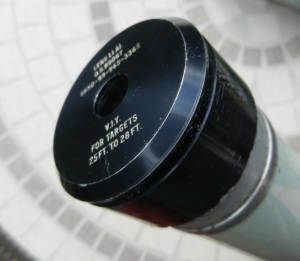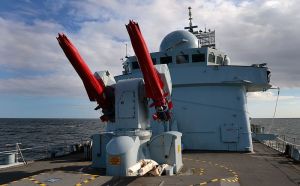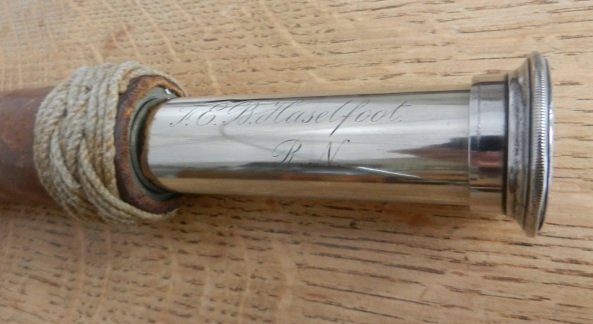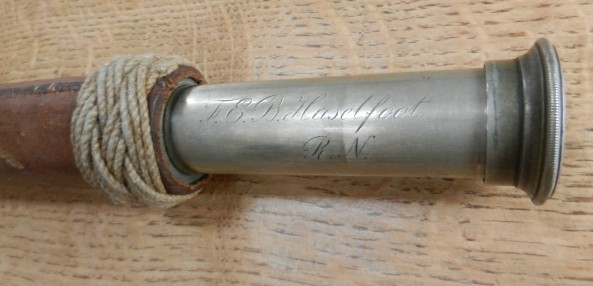 This is a style of telescope that is not normally a collector’s item, because it’s pretty difficult (normally) to do anything with them. This telescope belongs to the categories of: military equipment, heavy and bullet proof, un-damageable, gun-sights and range-finders. But the history of this one is why it’s so interesting.
This is a style of telescope that is not normally a collector’s item, because it’s pretty difficult (normally) to do anything with them. This telescope belongs to the categories of: military equipment, heavy and bullet proof, un-damageable, gun-sights and range-finders. But the history of this one is why it’s so interesting.
As described on Ebay it is a Gunsight Elbow Telescope AA Radar L6 A1, which was one of four such telescopes in service on HMS Gloucester, a Royal Navy Type 42 Destroyer. This was offered for sale when HMS Gloucester was decommissioned in Portsmouth in 2011. The wooden box which holds this scope identifies it as 6650-99-965-3364, and on the outside of the lid it is marked as belonging to the “Aft 909”, presumably the location and the ID of the radar antenna.
 The telescope itself is painted a grey colour, and labelled as Telescope Elbow AA Radar L4 A1, with the (presumably NATO) number 6650-99-962-6007. It has a 2” / 50mm OD main tube, with an objective aperture of 18-19mm: at the other end of the 12.5” / 32cm barrel, the diameter increases to 60mm where there are mounting slots/grooves to attach it to the radar aerial. The eyepiece is on the side, at 90 degrees to the optical axis, as you might expect from an elbow telescope. Focus is via a knurled knob on the rear end of the main barrel. So far it has not been dismantled.
The telescope itself is painted a grey colour, and labelled as Telescope Elbow AA Radar L4 A1, with the (presumably NATO) number 6650-99-962-6007. It has a 2” / 50mm OD main tube, with an objective aperture of 18-19mm: at the other end of the 12.5” / 32cm barrel, the diameter increases to 60mm where there are mounting slots/grooves to attach it to the radar aerial. The eyepiece is on the side, at 90 degrees to the optical axis, as you might expect from an elbow telescope. Focus is via a knurled knob on the rear end of the main barrel. So far it has not been dismantled.
The view through the telescope is good, although it offers quite a wide field of view, and limited magnification, compared to any other telescope. In the centre of the view there is a square measurement grid, showing two squares of angle off the centre line of view, one marked 10’ and the other 20’. Presumably these markings are minutes of arc, where 60 minutes is one degree – this seems to work out OK in measuring the observed thickness of a lamp-post at a distance. The eyepiece has a soft rubber cover.
 Also in the box is a separate push-on lens (Lens L1 A1, 6650-99-965-3365) to cover the objective, in a black housing, labelled “V.I.Y. for targets 25ft to 28ft”. It enables focussing the system on objects closer to the observer.
Also in the box is a separate push-on lens (Lens L1 A1, 6650-99-965-3365) to cover the objective, in a black housing, labelled “V.I.Y. for targets 25ft to 28ft”. It enables focussing the system on objects closer to the observer.
HMS Gloucester
The Destroyer HMS Gloucester was built by Vosper Thorneycroft in Southampton, and launched in November 1982: after commissioning in 1985 she served in the Royal Navy as D96, alongside the other 13 Type 42 Destroyers of this class. Two of these were lost in the South Atlantic, fighting to regain the Falklands – these were HMS Sheffield and HMS Coventry. After decommissioning, Gloucester was finally towed out of Portsmouth harbour on 22 September 2015, to be taken to a scrapyard in Turkey.
HMS Gloucester achieved distinction in the First Gulf War, in 1991, serving with the Task Force in the Persian Gulf. A previous HMS Gloucester, the Light Cruiser launched in 1937 and eventually sunk in the Mediterranean in 1941, had earned the name “Fighting G”, after ‘heavy service’ in those early years of WW2. The nickname was earned by the later HMS Gloucester primarily from the coalition task force US partners in the Persian Gulf, after the downing of an Iraqi Silkworm missile by a Sea Dart missile.
The entry in Wikipedia gives a useful outline of her full naval career:
Gloucester served in the Gulf War in 1991 under the command of Commander (later Rear Admiral) Philip Wilcocks where her most notable action was the firing of a salvo shot of Sea Dart missiles to shoot an Iraqi Silkworm missile that was threatening the US battleship USS Missouri and allied minehunters; the first successful missile versus missile engagement at sea in combat by any Navy. The ship also survived attacks from two naval mines and conducted numerous boardings using her boarding party consisting of Royal Navy and Royal Marine personnel. The ship’s Lynx helicopter also engaged seven Iraqi warships. She spent the longest period upthreat of any coalition warship. As a result of her endeavours, her captain (Commander Philip Wilcocks) and flight commander (Lt Cdr David Livingstone) were decorated with the Distinguished Service Cross; the operations officer and flight observer were both mentioned in Despatches. After this service Gloucester was rebranded with her nickname of “The Fighting G”.
In August 2010, Gloucester also intercepted and arrested the yacht Tortuga in the Caribbean, which was attempting to smuggle £4million worth of cocaine. This was during HMS Gloucester’s voyage out to the Falkland Islands, where she was deployed from August 2010 to early 2011.
What was the purpose?
What is the function of a telescope on a modern (1985 vintage) radar antenna? If you know please tell me!
By the description the radar is an anti-aircraft radar, ie presumably controlling a missile battery to launch the missile with a lock onto the right target being selected for tracking by the radar. Whether the initial radar target acquisition is intended to be confirmed visually by the operator looking through the telescope, (putting the target inside the graticule, if that is the right word) is unknown, maybe someone can tell me, but it seems the most logical duty for an Elbow Telescope on top of an AA Radar.
The Sea Dart missile required a separate radar illumination of the target to lock-on, and be guided to the target: Sea Dart firings where the missile was launched unguided were not successful. HMS Sheffield tried to disrupt their fatal attack by Exocet missiles by launching an unguided Sea Dart. In the action in the Gulf over the SilkWorm missile attack, the USS Jarrett guided missile Frigate launched a close-in defense missile system, in auto-engagement mode, which then (unfortunately) locked onto the defensive chaff already launched by the Missouri, and missed the missile. The Sea Dart salvo launched by HMS Gloucester was already locked onto the Iranian missile, presumably by the pre-launch lock – maybe achieved with the help of one of these four Elbow telescope systems on board.













